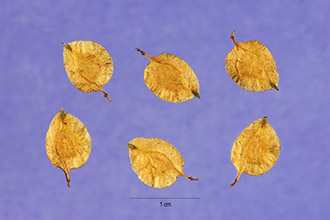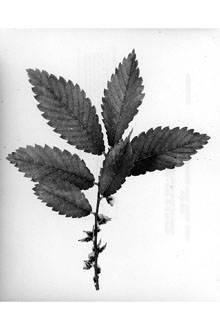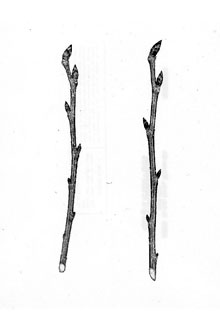Ulmus chinensis Pers.
Scientific Name: Ulmus chinensis Pers.

| General Information | |
|---|---|
| Usda Symbol | ULCH |
| Group | Dicot |
| Life Cycle | Perennial |
| Growth Habits | Tree |
| Native Locations | ULCH |
Plant Guide
Alternative Names
Drake elm, lacebark elm
Uses
Horticulture: Most of the elms make great shade and avenue trees, and Chinese elm is one of the best. It has been found to be invasive in some situations in Wisconsin. This is a good replacement for American elm which is apparently going extinct due to Dutch elm disease. Foliage in autumn often turns shades of red and purple. With its multi-colored exfoliating bark, Chinese elm is especially attractive in winter. There are some small cultivars that are used for bonsai. 'Hokkaido' has tiny leaves and gets only about 1 ft (0.3 m) tall. It is hardy enough to use in harsh planting situations such like parking lots, and in small planters along streets and in plazas or patios. Fairly resistant to maritime exposure, it can be grown in a shelter belt. Chinese elm is a tough tree, tolerant of urban air and soils, and resistant to Dutch elm disease. Fast growing and adaptable, this is a good choice when you want a shade tree for a small landscape. Additionally, hybridization between the Chinese and American elms has led to cultivars that are resistant to the disease, but they do not have the characteristic shape of the American elms. Although Chinese elm is an excellent tree, the variability of seedling stock can be seen in many streetscapes. Seed-grown trees can be misshapen, and will not necessarily fulfill the role chosen for them. Trees budded onto understocks will give a more uniform tree, and can be managed more efficiently. Cutting-grown trees maintain clonal stability, but can be slow to establish because of a less-vigorous root system. Chinese elm can develop more than one dominant leader when young, making it difficult to manage in the streetscape. Purchase only trees with a single leader to prevent high maintenance costs later in the landscape Ethnobotanic: Raw or cooked immature fruits are used just after they are formed (Tanaka 1976). It has an aromatic, unusual flavor, leaving the mouth feeling fresh and the breath smelling pleasant. It contains about 34.4% protein, 28.2% fat, 17% carbohydrate, 5% ash. Cooking the inner bark produces a mucilaginous texture (Tanaka 1976; Kunkel 1984). No more details are given but inner bark is often dried, ground into a powder and then used as a thickening in soups etc or mixed with cereals when making bread. The leaves are purported to be an antidote and lithontripic. The stem bark is a demulcent, diuretic, expectorant, febrifuge, hypnotic and lithontripic. The flowers are used in the treatment of fevers and neuritis (Duke & Ayensu 1985).
Status
Please consult the PLANTS Web site and your State Department of Natural Resources for this plant’s current status, such as, noxious status, and wetland indicator values, Use soil moisture sensors to measure the soil moisture of Ulmus chinensis Pers..,
Description
The Chinese elm is native to China, Korea, and Japan. It is a small to medium-sized deciduous (rarely semi-evergreen) tree growing to 10-18 m tall with a slender trunk and crown. The leaves are small, 2-5 cm long and 1-3 cm broad. The flowers are produced in early autumn, small and inconspicuous, with the seed maturing rapidly and dispersing by late autumn. The fruit are round samaras appearing in the fall. The growth rate of Chinese elm can be over 3 feet per year reaching 60 to 80 feet tall. It has beautiful exfoliating bark which is cinnamon in color. It grows in a vase shape and is a good city tree resistant to Dutch Elm disease. It is drought tolerant, but will tolerate moist sites. It can be messy with lots of fruit falling and causing seedling growth. When receiving a shipment, make sure it is not Ulmus pumila (which has a black, rounded bud). Trees retain their leaves until early in the new year and in areas with mild winters will often retain them until new leaves are formed in the spring. This tree likes full sun to partial shade and grows in USDA Hardiness Zones 5-9.
Establishment
This species is easily grown in any soil of at least moderate quality so long as it is well drained. The various species of elm hybridize freely. The pollen stores well and can be kept for use with species that flower at different times (Huxley 1992). Propagation by seed. Sow seed outside in containers as soon as they ripen in fall. Cultivars are sometimes grafted onto seedlings. Greenwood tip cuttings may be rooted under glass with bottom heat. If sown in a cold frame as soon as it is ripe, it usually germinates within a few days (Huxley 1992). Stored seed does not germinate so well and should be sown in early spring. One to two months of stratification can improve germination rates. The seed can also be harvested 'green' (when it has fully developed but before it dries on the tree) and sown immediately in a cold frame. It should germinate very quickly and will produce a larger plant by the end of the growing season (McMillan-Browse 1985). When they are large enough to handle, prick the seedlings out into individual pots and grow them on in the greenhouse for their first winter. Plant them out into permanent positions in late spring or early summer, after the last expected frosts. Plants should not be allowed to grow for more than two years in a nursery bed, since they form a tap root and will then be difficult to move. Layering can be done on suckers or coppiced shoots (Huxley 1992).
Management
It is easily grown in any soil of at least moderate quality so long as it is well drained (Bean 1981). Fairly tolerant of maritime exposure, it succeeds outdoors in a very exposed position. It is resistant to Dutch elm disease, which is spread by a beetle. There is no effective cure for the problem, but most east Asian, though not Himalayan, species are resistant (though not immune) to the disease so the potential exists to use these resistant species to develop new resistant hybrids with the native species. The various species hybridize freely, the pollen stores well and can be kept for use with species that flower at different times (Huxley 1992). Trees retain their leaves until early in the new year (Bean 1981) and in areas with mild winters will often retain them until new leaves are formed in the spring (Brickell 1990). A good companion for grapes (Philbrick & Gregg 1979). Cultivars, Improved and Selected Materials (and area of origin) Many cultivars of this species have been released such as 'Drake', 'Frosty', and 'True Green'. ‘Pumila’ is a minute bush for rock gardens. Contact your local Natural Resources
Conservation
Service (formerly Soil Conservation Service) office for more information. Look in the phone book under ”United States Government.” The Natural Resources Conservation Service will be listed under the subheading “Department of Agriculture.”
References
Bean. W.J. & D.L. Clarke. 1991. Trees and shrubs hardy in the British Isles. John Murray, London. 864p. Brickell. C. 1990. The RHS gardener's encyclopedia of plants and flowers. Dorling Kindersley Publishers Ltd, New York. Chittendon, F. 1956. RHS dictionary of plants plus supplement. Oxford University Press, U.K. Duke. J. A. & E.S. Ayensu. 1985. Medicinal plants of China. Reference Publications, Inc., Algonac, Michigan. Flora of China Project 2007. Flora of China. Accessed: 070212. Harvard University, Cambridge, Massachusetts. <http://flora.huh.harvard.edu/china/index.html> Gregg, R.B. 1966. Companion plants. Devin-Adair Co., Greenwich, Connecticut. Huxley. A. 1992. The new RHS dictionary of gardening. MacMillan Press, U.K. Kunkel. G. 1984. Plants for human consumption. Koeltz Scientific Books, Koenigstein, Germany. McMillan-Browse. P. 1985. Hardy woody plants from seed. Grower Books, London. Philbrick, H.L.P. 1976. Companion plants and how to use them. Shambhala Publications, Boston. 113p. Plants for a Future 2006. Plants for a future. (Accessed: 060902) England, U.K. Tanaka. T. 1976. Tanaka's cyclopaedia of edible plants of the world. Keigaku Publishing Co., Tokyo. USDA NRCS. 2007. The PLANTS database. Acessed: 070212. National Plant Data Center, Baton Rouge, Louisiana.
Plant Traits
Growth Requirements
| Cold Stratification Required | Yes |
|---|---|
| Hedge Tolerance | Low |
| Hedge Tolerance | Low |
| Frost Free Days, Minimum | 140 |
| Frost Free Days, Minimum | 140 |
| Fire Tolerance | Medium |
| Fire Tolerance | Medium |
| Fertility Requirement | Medium |
| Fertility Requirement | Medium |
| Drought Tolerance | Medium |
| Drought Tolerance | Medium |
| Cold Stratification Required | Yes |
| Temperature, Minimum (°F) | -33 |
| CaCO3 Tolerance | Low |
| CaCO3 Tolerance | Low |
| Anaerobic Tolerance | None |
| Anaerobic Tolerance | None |
| Adapted to Medium Textured Soils | Yes |
| Adapted to Medium Textured Soils | Yes |
| Adapted to Fine Textured Soils | Yes |
| Adapted to Fine Textured Soils | Yes |
| Adapted to Coarse Textured Soils | Yes |
| Adapted to Coarse Textured Soils | Yes |
| Moisture Use | Medium |
| Temperature, Minimum (°F) | -13 |
| Shade Tolerance | Intolerant |
| Shade Tolerance | Intolerant |
| Salinity Tolerance | None |
| Salinity Tolerance | None |
| Root Depth, Minimum (inches) | 24 |
| Root Depth, Minimum (inches) | 24 |
| Precipitation, Minimum | 16 |
| Precipitation, Minimum | 16 |
| Precipitation, Maximum | 55 |
| Precipitation, Maximum | 55 |
| Planting Density per Acre, Minim | 300 |
| Planting Density per Acre, Minim | 300 |
| Planting Density per Acre, Maxim | 800 |
| Planting Density per Acre, Maxim | 800 |
| pH, Minimum | 4.8 |
| pH, Minimum | 4.8 |
| pH, Maximum | 7.0 |
| pH, Maximum | 7.0 |
| Moisture Use | Medium |
Morphology/Physiology
| Active Growth Period | Spring and Summer |
|---|---|
| Toxicity | None |
| Toxicity | None |
| Shape and Orientation | Erect |
| Fire Resistant | No |
| Foliage Texture | Coarse |
| Foliage Texture | Coarse |
| Foliage Porosity Winter | Porous |
| Foliage Porosity Winter | Porous |
| Foliage Porosity Summer | Dense |
| Foliage Porosity Summer | Dense |
| Foliage Color | Green |
| Foliage Color | Green |
| Flower Conspicuous | No |
| Flower Conspicuous | No |
| Flower Color | Yellow |
| Flower Color | Yellow |
| Resprout Ability | Yes |
| Fire Resistant | No |
| Fall Conspicuous | Yes |
| Fall Conspicuous | Yes |
| Coppice Potential | Yes |
| Coppice Potential | Yes |
| C:N Ratio | High |
| C:N Ratio | High |
| Bloat | None |
| Bloat | None |
| Active Growth Period | Spring and Summer |
| Shape and Orientation | Erect |
| Fruit/Seed Color | Brown |
| Resprout Ability | Yes |
| Nitrogen Fixation | None |
| Nitrogen Fixation | None |
| Low Growing Grass | No |
| Low Growing Grass | No |
| Lifespan | Moderate |
| Lifespan | Moderate |
| Leaf Retention | No |
| Leaf Retention | No |
| Known Allelopath | No |
| Known Allelopath | No |
| Height, Mature (feet) | 60.0 |
| Height, Mature (feet) | 60.0 |
| Fruit/Seed Color | Brown |
| Fruit/Seed Conspicuous | Yes |
| Fruit/Seed Conspicuous | Yes |
| Growth Form | Single Stem |
| Growth Form | Single Stem |
| Growth Rate | Rapid |
| Growth Rate | Rapid |
| Height at 20 Years, Maximum (fee | 40 |
| Height at 20 Years, Maximum (fee | 40 |
Reproduction
| Propagated by Cuttings | No |
|---|---|
| Propagated by Seed | Yes |
| Propagated by Seed | Yes |
| Propagated by Sod | No |
| Propagated by Sod | No |
| Propagated by Sprigs | No |
| Propagated by Sprigs | No |
| Propagated by Tubers | No |
| Propagated by Tubers | No |
| Seed per Pound | 160000 |
| Seed per Pound | 160000 |
| Seed Spread Rate | Moderate |
| Fruit/Seed Period Begin | Spring |
| Seed Spread Rate | Moderate |
| Seedling Vigor | High |
| Seedling Vigor | High |
| Small Grain | No |
| Small Grain | No |
| Vegetative Spread Rate | None |
| Vegetative Spread Rate | None |
| Propagated by Corm | No |
| Propagated by Cuttings | No |
| Bloom Period | Late Summer |
| Bloom Period | Late Summer |
| Commercial Availability | Routinely Available |
| Commercial Availability | Routinely Available |
| Fruit/Seed Abundance | High |
| Fruit/Seed Abundance | High |
| Fruit/Seed Period Begin | Fall |
| Fruit/Seed Period End | Fall |
| Fruit/Seed Period End | Spring |
| Fruit/Seed Persistence | No |
| Propagated by Bare Root | Yes |
| Propagated by Bare Root | Yes |
| Propagated by Bulb | No |
| Propagated by Bulb | No |
| Propagated by Container | Yes |
| Propagated by Container | Yes |
| Propagated by Corm | No |
| Fruit/Seed Persistence | No |
Suitability/Use
| Naval Store Product | No |
|---|---|
| Nursery Stock Product | Yes |
| Nursery Stock Product | Yes |
| Palatable Human | No |
| Palatable Human | No |
| Post Product | No |
| Post Product | No |
| Pulpwood Product | No |
| Pulpwood Product | No |
| Veneer Product | No |
| Veneer Product | No |
| Naval Store Product | No |
| Lumber Product | Yes |
| Lumber Product | No |
| Fuelwood Product | Medium |
| Fuelwood Product | Medium |
| Fodder Product | No |
| Fodder Product | No |
| Christmas Tree Product | No |
| Christmas Tree Product | No |
| Berry/Nut/Seed Product | No |
| Berry/Nut/Seed Product | No |


